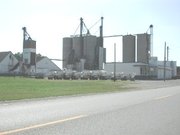Grain elevator
|
|
This article is about grain elevators. For other meanings of "elevator" see Elevator (disambiguation).
 A grain elevator outside London, Ontario Missing image Halfmileelevator.jpg Half-mile long grain elevator in Hutchinson, Kansas Missing image Grain_elevator8089.JPG A grain elevator in Hemingway, South Carolina |
Grain elevators are buildings or complexes of buildings for storage and shipment of grain. The term became common in the late 19th century, at which time bucket elevators for lifting grain first came into use. Bucket elevators lift grain to a distribution point, where it can flow by gravity into one of a number of bins, which are then unloaded by gravity. The bins and their unloading chutes are often sited in such a way that rail cars or barges can be filled from them directly.
Prior to the advent of the grain elevator, grain was handled in bags rather than in bulk.
Grain elevators are a constant sight in the grain-growing areas of the world, such as the North American prairies. Larger terminal elevators are found at distribution centers, such as Chicago and Thunder Bay, Ontario, where grain is sent for processing, or loaded aboard trains or ships to go further afield.
Originally each small town had its own small grain elevator that would serve the local farmers. The classic grain elevator was made of wood and had 12 rectangular bins arranged in a 3x4 pattern. In more recent times with improved transportation, centralized and much larger elevators serve many farms. Some of them are quite large. Two elevators in Kansas (one in Hutchinson and one in Wichita) are half a mile long. The loss of the grain elevators from small towns is often considered a great change in their identity and there are efforts to preserve them as heritage structures. At the same time, many larger grain farms have their own grain handling facilities for storage and loading onto trucks.
Grain elevator operators buy grain from farmers, either for cash or at a contracted price, and then sell futures contracts for the same quantity of grain, usually each day. They profit through the narrowing basis, that is, the difference between the local cash price, and the futures price, that occurs at certain times of the year.
Before economical truck transportation was available, grain elevator operators would sometimes use their purchasing power to control prices. This was especially easy since farmers often had only one elevator that was within a reasonable distance of their farm. This has led some governments to take over the administration of grain elevators. An example of this is the Saskatchewan Wheat Pool. Many elevators were purchased by cooperatives.
A recent problem with grain elevators is the need to provide separate storage for ordinary and genetically modified grain to reduce the risk of accidental mixing of the two.
An interesting problem the old elevators had was that of silo explosions. Fine powder from the millions of grains passing through the facility would accumulate in the air. A spark could spread from one floating grain to the other creating a chain reaction that would destroy the entire structure. (This dispersed-fuel explosion is the mechanism behind fuel-air bombs.) To prevent this elevators have very rigorous rules against smoking or any other open flame.


